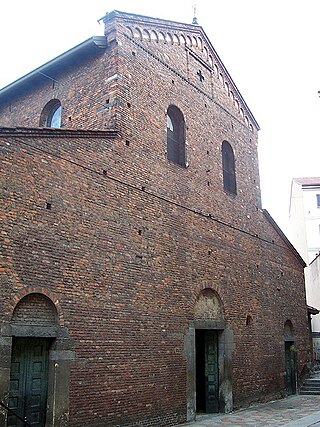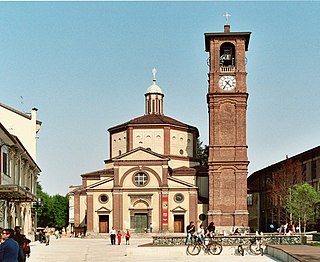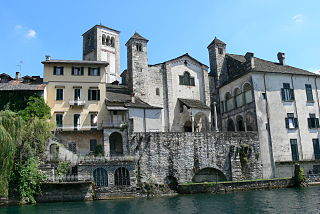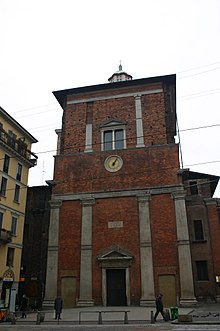
A mosaic is a pattern or image made of small regular or irregular pieces of colored stone, glass or ceramic, held in place by plaster/mortar, and covering a surface. Mosaics are often used as floor and wall decoration, and were particularly popular in the Ancient Roman world.

Sant'Ambrogio e Carlo al Corso is a basilica church in Rome, Italy, facing onto the central part of the Via del Corso. The apse of the church faces across the street, the Mausoleum of Augustus on Via di Ripetta.

Santa Pudenziana is a church of Rome, a basilica built in the 4th century and dedicated to Saint Pudentiana, sister of Praxedes and daughter of Pudens. It is one of the national churches in Rome, associated with Filipinos.

Santi Nereo ed Achilleo is a fourth-century basilica church in Rome, Italy, located in via delle Terme di Caracalla in the rione Celio facing the main entrance to the Baths of Caracalla. It has been the titular church of Cardinal Celestino Aós Braco since 28 November 2020.

The Basilica of Sant'Ambrogio is an ancient Romanesque-style, Roman Catholic church in the center of Milan, region of Lombardy, Italy.

The Basilica of Sant'Eustorgio is a church in Milan in northern Italy, which is in the Basilicas Park city park. It was for many years an important stop for pilgrims on their journey to Rome or to the Holy Land, because it was said to contain the tomb of the Three Magi or Three Kings.

The Basilica of San Simpliciano is an ancient Roman Catholic church in the centre of Milan, region of Lombardy, Italy: the church, commissioned by the 4th century bishop St Ambrose, is the second oldest known Christian church with a Latin cross layout. It is dedicated to Saint Simplician, who was Ambrose's successor as bishop of Milan.

Santa Maria presso San Satiro is a church in Milan. The Italian Renaissance structure (1476–1482) houses the early medieval shrine to Satyrus, brother of Saint Ambrose. The church is known for its false apse, an early example of trompe-l'œil, attributed to Donato Bramante.

The Basilica of San Lorenzo Maggiore is a Roman Catholic church in Milan, Northern Italy. Located within the city's ring of navigli, it is one of the oldest churches in the city, originally built in Roman times, but subsequently rebuilt several times over the centuries. It is close to the medieval Porta Ticinese and near the Basilicas Park, which includes both the Basilica of San Lorenzo and the Basilica of Sant'Eustorgio, as well as the Roman Colonne di San Lorenzo.

Padua Cathedral, or Basilica Cathedral of Saint Mary of the Assumption, is a Catholic church and minor basilica located on the east end of Piazza Duomo, adjacent to the bishop's palace in Padua, Veneto, Italy.

The Basilica of San Michele Maggiore is a Roman Catholic church in Pavia, region of Lombardy, Italy. The building, dating to the 11-12th centuries, is a well-preserved example of the Lombard-Romanesque style.

Giovan Battista della Cerva was an Italian painter.

The basilica of San Vincenzo in Prato is a Roman Catholic church located in Via Daniele Crespi 6, in Milan, region of Lombardy, Italy. The church maintains most of its original Palaeo-Christian appearance.

Italy has the richest concentration of Late Antique and medieval mosaics in the world. Although the art style is especially associated with Byzantine art and many Italian mosaics were probably made by imported Greek-speaking artists and craftsmen, there are surprisingly few significant mosaics remaining in the core Byzantine territories. This is especially true before the Byzantine Iconoclasm of the 8th century.

The Portinari Chapel is a Renaissance chapel at the Basilica of Sant'Eustorgio, Milan, northern Italy. Commenced in 1460 and completed in 1468, it was commissioned by Pigello Portinari as a private sepulchre and to house a silver shrine given by Archbishop Giovanni Visconti in 1340 containing the relic head of St. Peter of Verona, to whom the chapel is consecrated. The architect is unknown, the traditional attribution to Michelozzo having been succeeded with equal uncertainty by attributions to either Filarete or Guiniforte Solari, architect of the apses of the Certosa di Pavia and the church of San Pietro in Gessate in Milan.

The basilica of Santo Stefano encompasses a complex of religious edifices in the city of Bologna, Italy. Located on Piazza Santo Stefano, it is locally known as Sette Chiese and Santa Gerusalemme. It has the dignity of minor basilica.

A martyrium (Latin) or martyrion (Greek), sometimes anglicized martyry, is a church or shrine built over the tomb of a Christian martyr. It is associated with a specific architectural form, centered on a central element and thus built on a central plan, that is, of a circular or sometimes octagonal or cruciform shape.

The Abbey of Santa Giustina is a 10th-century Benedictine abbey complex located in front of the Prato della Valle in central Padua, region of Veneto, Italy. Adjacent to the former monastery is the basilica church of Santa Giustina, initially built in the 6th century, but whose present form derives from a 17th-century reconstruction.

The Basilica of Saint Magnus is the principal church of the Italian town of Legnano, in the province of Milan. It is dedicated to the Saint Magnus, who was Archbishop of Milan from 518 to 530. The church was built from 1504 to 1513 in the Renaissance-style designed by Donato Bramante. The bell tower was added between the years 1752 and 1791. On 18 March 1950, Pope Pius XII named the Basilica of San Magno a minor basilica.

The Basilica di San Giulio is a Roman Catholic church on the small Isola San Giulio in the center of Lake Orta, province of Novara, north-western Italy. It has the status of a minor basilica. Although the island is part of the Orta San Giulio municipality, the basilica belongs to the San Giacomo parish, including the island and a portion of the west coast of the lake in San Maurizio d'Opaglio municipality.


























